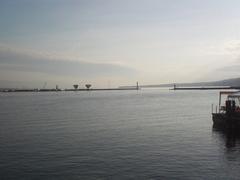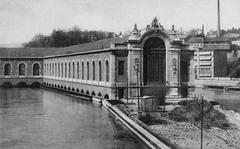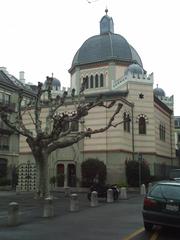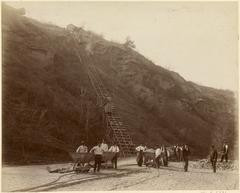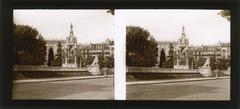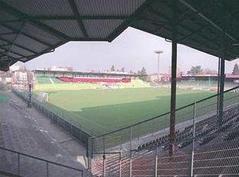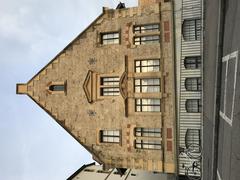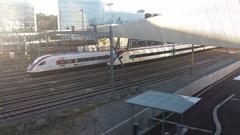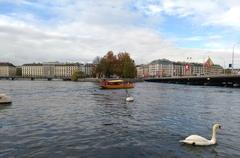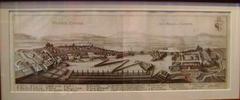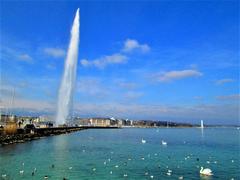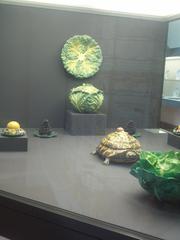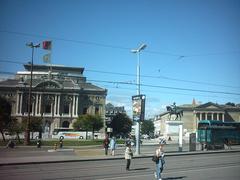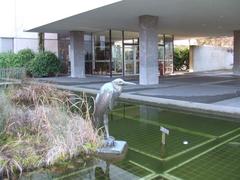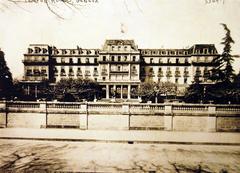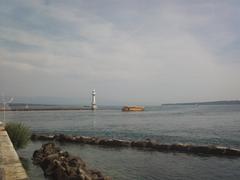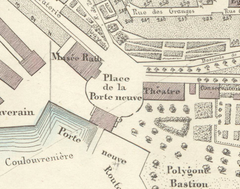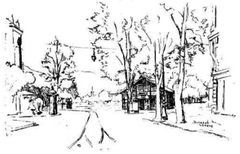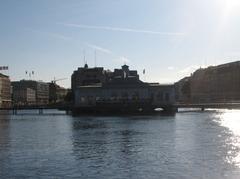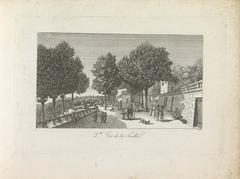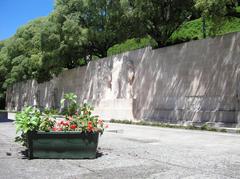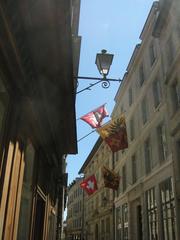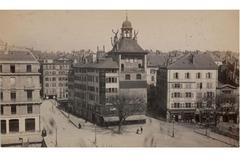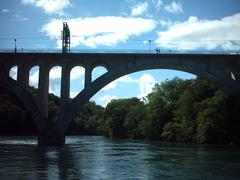
Pont de Vessy: Visiting Hours, Tickets, and Travel Guide – Geneva, Switzerland
Date: 04/07/2025
Introduction
Pont de Vessy is an iconic bridge in Geneva, Switzerland, seamlessly blending architectural innovation, industrial legacy, and natural beauty. Designed by Robert Maillart, a pioneer of reinforced concrete architecture, the bridge not only serves as a vital crossing over the Arve River but also stands as a monument to Geneva’s commitment to sustainable development and heritage preservation. With its proximity to Les Berges de Vessy—a former water pumping station now transformed into a vibrant ecological and cultural hub—Pont de Vessy offers visitors a unique opportunity to explore Geneva’s past, present, and future. This comprehensive guide provides all the essential information for an enriching visit, including historical context, architectural highlights, visitor tips, access details, and recommended nearby attractions.
For additional details and real-time updates, consult the official Les Berges de Vessy exhibition website, MySwitzerland, and the Wikipedia page on Pont de Vessy.
Table of Contents
Discover Pont de Vessy: A Historic Gem in Geneva
Nestled in the Vessy district of Geneva, Pont de Vessy is more than a bridge—it’s a testament to the city’s industrial growth, architectural achievement, and environmental stewardship. Whether you are a cultural explorer, history buff, or seeking a tranquil riverside escape, Pont de Vessy provides a multidimensional experience that bridges Geneva’s past and present.
Historical Background
Origins and Early Development
Pont de Vessy and the Les Berges de Vessy site have played a pivotal role in Geneva’s water management since the mid-19th century. The original water pumping station, inaugurated in 1865, was essential for ensuring the city’s clean water supply and supporting rapid urbanization (Les Berges de Vessy exposition). The bridge itself facilitated critical access across the Arve River, helping to connect expanding neighborhoods and industries.
Robert Maillart’s 1936 Redesign
In 1936, renowned Swiss engineer Robert Maillart redesigned Pont de Vessy, introducing his characteristic use of reinforced concrete and an innovative three-hinged arch supported by distinctive X-shaped vertical struts (notrehistoire.ch). The project not only addressed technical and aesthetic challenges but also provided much-needed employment during the economic downturn of the era.
Transition to Environmental and Cultural Significance
As industrial needs evolved and environmental awareness grew, Les Berges de Vessy shifted from a purely functional site to a model of sustainable development. The historic pumping station now operates as a micro-hydropower plant, generating renewable energy while serving as a museum and educational venue. The riverbanks have been restored as protected habitats, reflecting Geneva’s commitment to biodiversity and ecological education (MySwitzerland).
Architectural and Cultural Significance
Structural Design and Engineering
Pont de Vessy is celebrated for its elegant, utilitarian design. Maillart’s use of reinforced concrete allowed for slender arches and minimal supports, creating both visual lightness and structural robustness (Komoot). The bridge spans 56 meters and features separated pedestrian and cycling paths alongside vehicular lanes, ensuring both safety and accessibility.
Integration with the Environment
The bridge’s understated design harmonizes with the surrounding natural landscape. Its neutral concrete tones blend with the lush riverbanks and forested areas, while open railings maximize views of the Arve River and facilitate a strong visual connection with nature (MySwitzerland).
Heritage and Educational Value
Pont de Vessy and Les Berges de Vessy together form a living classroom on the evolution of Geneva’s water management, industrial technology, and environmental stewardship. The site regularly hosts exhibitions, workshops, and guided tours focused on renewable energy, cultural heritage, and sustainable development (artageneve.com).
Artistic and Photographic Inspiration
The bridge’s unique X-shaped supports, open deck, and riverside setting make it a favorite subject for photographers and artists. Seasonal changes along the Arve offer a dynamic backdrop, and the area’s tranquil ambiance is ideal for creative pursuits (Wikimedia Commons).
The Setting: Les Berges de Vessy
Industrial Past and Environmental Present
Les Berges de Vessy is a model of adaptive reuse, transforming a historic pumping station into a center for environmental education and cultural activities. The site’s micro-hydroelectric plant, certified with the “naturemade star” label, demonstrates Geneva’s innovative approach to sustainability (ww2.sig-ge.ch).
Cultural and Educational Offerings
The “Maison du Futur” (House of the Future) at Les Berges de Vessy offers a range of temporary exhibitions, workshops, and community events on topics such as renewable energy and biodiversity. The area also provides meeting rooms and a cafeteria for group activities (myswitzerland.com). In 2025, the exhibition “Les Berges de Vessy, une histoire entre nature et industrie” will trace the site’s journey from industrial hub to ecological sanctuary (ww2.sig-ge.ch).
Visitor Information
Visiting Hours and Tickets
- Pont de Vessy: The bridge is a public infrastructure open 24/7, with free access at all times—no tickets required.
- Les Berges de Vessy / Maison du Futur: Open Tuesday to Friday, 13:00–17:00; weekends, 10:00–17:00; closed Mondays (artageneve.com). Entry is generally free; some special events may require registration or a fee.
Accessibility
The bridge and main paths are wheelchair accessible, with smooth walkways, ramps, and separated pedestrian and cycling lanes. Some areas of the historic pumping station may have limited access—check in advance if you have specific needs (geneve.com).
Getting There
- Public Transport: Take bus lines 34, 36, or 38 to the Vessy stop. Geneva’s public transport is efficient and accessible (Geneva.com).
- Bicycle/Foot: Dedicated cycling and pedestrian paths connect Pont de Vessy to the city center and surrounding districts (Grands Esserts FAQ).
- Car: Limited parking is available at Les Berges de Vessy and nearby underground lots. Public transport or cycling is recommended for convenience and sustainability.
Amenities
- Restrooms: Available in nearby parks and recreational areas.
- Shops/Services: Grocery, pharmacy, and other services are planned in the adjacent Grands Esserts district (Grands Esserts FAQ).
- Food/Drink: Geneva’s diverse dining scene is easily accessible; bring snacks or plan a picnic by the river.
Travel Tips and Nearby Attractions
- Best Time to Visit: Spring through autumn for pleasant weather and vibrant scenery.
- Combine Your Visit: Explore nearby Parc La Grange, Parc des Eaux-Vives, Geneva’s Old Town, and Lake Geneva (planetware.com).
- What to Bring: Comfortable walking shoes, camera, water, and weather-appropriate clothing.
Visitor Experience
Activities
- Bridge Walks & River Views: Enjoy panoramic vistas and tranquil riverbank strolls.
- Cycling: Well-marked bike routes connect Pont de Vessy with other parts of Geneva.
- Nature & Birdwatching: The protected banks of the Arve harbor diverse flora and fauna.
- Industrial Heritage Tours: Guided tours of Les Berges de Vessy explain the evolution of Geneva’s waterworks and renewable energy initiatives (artageneve.com).
- Art & Photography: Capture the bridge’s striking architectural features and scenic surroundings.
Safety and Regulations
- Pedestrian/Cyclist Safety: Use designated paths; cyclists should ride slowly in shared zones.
- Dog Walking: Dogs on leashes are welcome along the bridge and riverside paths.
- Traffic: Check for temporary road changes due to urban development (Grands Esserts FAQ).
Environmental and Urban Context
Urban Development
The Grands Esserts project is reshaping the area with new housing, schools, and green spaces, promoting sustainable mobility and enhancing the visitor experience (Grands Esserts FAQ).
Sustainability
Geneva encourages eco-friendly transport by expanding bike paths and public transport, and minimizing car use. The micro-hydropower station at Les Berges de Vessy underlines the city’s investment in renewable energy and environmental stewardship.
Frequently Asked Questions (FAQ)
Is Pont de Vessy open 24/7?
Yes, the bridge is accessible at all times with no restrictions or fees.
Are there entrance fees?
No, access to Pont de Vessy and outdoor areas at Les Berges de Vessy is free. Some exhibitions or workshops may require registration or a small fee.
Is the site wheelchair accessible?
Yes, the bridge and main paths are suitable for wheelchair users; some historic buildings may have limited access.
Are guided tours available?
Yes, guided tours of Les Berges de Vessy and the hydroelectric plant are available by reservation.
Can I bring my dog?
Yes, dogs on leashes are welcome on the bridge and riverside trails.
How do I get there via public transport?
Take buses 34, 36, or 38 to the Vessy stop; cycling and walking routes are also well-marked.
Conclusion and Call to Action
Pont de Vessy is a living testament to Geneva’s industrial history, architectural innovation, and environmental vision. With 24/7 free access, seamless integration into public transport and cycling networks, and a wealth of cultural and natural attractions nearby, it offers something for every visitor. To enrich your experience, check the latest event schedules, download the Audiala app for audio guides, and follow Geneva’s official tourism channels.
Plan your visit today to discover how heritage, nature, and innovation converge at Pont de Vessy—Geneva’s bridge between past and future.



